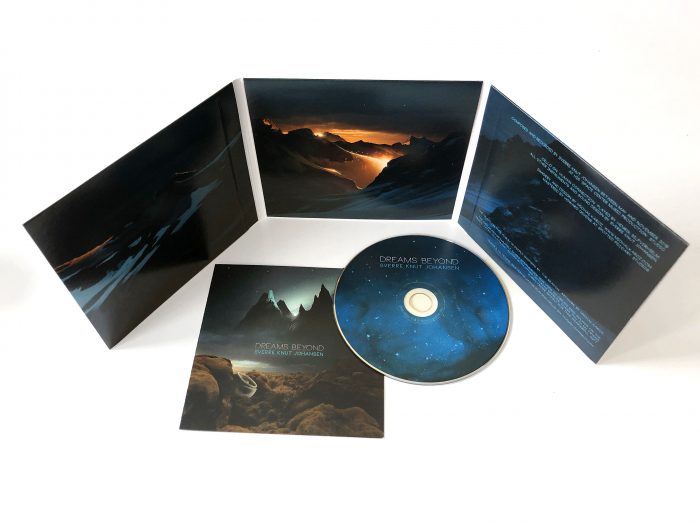The music of Sverre Knut Johansen has always had rich content and strong melodic elements that have become his trademark, both lyrical and rhythmic and often with elements of classical and electronic ambient music genres. Dreams Beyond, Johansen’s fifth offering on the Spotted Peccary label, is a wondrous adventure through musical visions and sonic dreamscapes, inspired by the album’s striking and surreal cover artwork created by Michał Karcz.
Guiding the listener on a fascinating voyage, the album’s nine tracks travel through quiet spaces and mysterious realms, frequently propelled by dynamic rhythms that build to powerfully dramatic moments. Using his collection of synths, electronic percussion, electric guitars, and sound design software, Johansen infuses the tracks with a creativity that satisfies the ears and sparks the imagination, weaving melody, rhythm, and texture into a captivating musical tapestry that constantly evolves from beginning to end. Inspired and sincere, Dreams Beyond is bestowed with passion and warmth. It is a thoroughly enjoyable exploration that invites us to follow our dreams into the unknown and beyond, seeking – and discovering – a peaceful paradise of long days and beautiful landscapes, safe from danger, and hidden from the outside world.
The album is almost a solo effort, with all instruments and sound design by Johansen except for a cello performance by Henrik Silfverhielm on the emotive track “Human Connection.” Delving into “synth” territory in a recent conversation with music journalist Robin James, Johansen said “The dramatic bird sounds I use in ‘Tatra Mountains’ are a big part of this song as they create a more dramatic and intense vibe throughout the track. These two minutes I created with these sounds are important to the whole album as I also use them elsewhere to link the tracks together. The bird sounds on ‘Tatra Mountains’ along with different effects and synth sounds were crafted from the OSCar programmable Music Synthesizer.”
Following up with an impressionistic review, James wrote, “With a sound signal like whistling, the title track emerges, leading into a stop and start sequencer pattern that keeps repeating and building: ‘Dreams Beyond’ (10:54). Unseen creatures continue to whistle from the void, calling out to each other to enhance their telepathic illusions, thoughts dance upon the pillows of oblivion. What I hear next reminds me of the majestic beauty of creation and all those who love the silence and calm of the mountains; ‘Dawn’ (4:01) is the frontier of the void, light emerges with varying shapes of the crystal-image spreading luster across the sky.”
The inspirational cover art is titled “The Beacon” and was created by painter-turned-photographer Michał Karcz, who has established himself as a maker of detailed sound-inspired illustrations for imaginative fantasy worlds. “Most of my work is like a journey to the places which don’t exist. Places from my dreams, desire, imagination and fears.” He continues, “I can tell that music has the biggest impact on my work. It’s an inseparable element with pictures in my mind, a kind of sound illustration to a visible scenery. These two things hit me with the strongest intensity.”
I had the opportunity to exchange email with Sverre Knut Johansen in August of 2020, The first question I asked him was about how the album came about. This is what he told me.
SKJ: I guess I chose the picture because it reflected the music I want to make. Also I had this title “Beyond Dreams” in my mind for some years, and this fine picture also reflected this title. When I was working with the music I always used BEACON as my screensaver, for when I compose and when I listen.
The meaning of the title Dreams Beyond is to explore and follow our dreams beyond the unknown, finding, searching and discovering a secret treasure (a paradise) hidden from the outside world, a peaceful place with long days surrounded by birds, beautiful landscapes, safe from all danger in this world. A healing place.
The music is more ambient than what I have recorded before this time and some sounds also pull the music in a more orchestral direction.
(Now I would like to pause in the interview and take a closer look at the music.)
The story never begins or ends – it merely ‘becomes.’
The last of the summer moons have begun to wane, the old crows break their long silence and begin to shriek strange cries from the darkness, expressing dark moods framed by adventurous melodies that haunt the ancient mountains. These are the Tatra Mountains, the highest mountain range in the Carpathian Mountains, which form a natural border between Slovakia and Poland. Their topography causes one of the most diverse climates in that region. Leo Frankowski mentions the Tatras several times in his Conrad Stargard series of science fiction novels, also there is mention of these same mountains in The Wolves of Time, a series written by William Horwood. The composer Karol Szymanowski on occasion found inspiration with the distinctive traditional music of the same Tatra mountains in southern Poland. The opening track sets this listening adventure in motion, “Tatra Mountains (Introduction)” (4:40).
The term Tatra is a general expression in Slovak for barren or stony land, and in Russian for rocks and small stones in a river. The Tatra Mountains are home to many species of animals and insects and this song includes many imaginative clues that may trigger your ideas of what those beings might be doing. The track “Tatra Mountains” (8:35) presents a melody that haunts the wonderful meadows just under huge lime cliffs, walk through the valleys and then climb the higher parts of the range and behold the soaring landscape all around. The Legend of the Sleeping Knights is a folktale from the Tatra region, inspired by the outline of one of the most famous peaks, Giewont, which is said to resemble the posture of the sleeping knight.
You are now floating gently above the delicately painted sleeping knight, now surging towards ecstatic climaxes, now yielding to the hypnotic strains of a wordless dance. My favorite track is “Causeway” (9:48), an interesting journey through many layers and textures on a raised road across wet ground. I hear electronic insect sounds, portraying a trail through night and mystery, time and room variously for romance and terror, and letting go. Imagine discovering that you have already fallen into some accidental time travel to prior historical settings, and have been left stranded. Imagine being suddenly transported into the past, and managing to make something by exploiting all the things you know from having studied history. The mood is slow and vast, ever stranger events rekindle the fires of a dying universe. “Echoes of the Past” (9:19)
The final track is titled “Human Connection” (6:38) and is a reflective processional meditation, in my mind’s eye I can see lines of pilgrims climbing the mountain to find gems holding the powers of the season. The cello is played by Henrik Silfverhielm, and the synthesizers provide the situation.
Q: What equipment did you use for this project?
SKJ: There are two important synth pads that have been great for making this album: The “Equinox” Pad from PRISM for REAKTOR By Native Instruments and the “Epic Majestic” Pad from OmniChill by Plugin Guru for Omnisphere.
The Epic Majestic Pad is the foundation for the two “Tatra Mountains” tracks, also giving life and passion to “Dreams Beyond” and “Awakening” tracks.
I have for some years been thinking about the guitar and for this album I asked some friends and borrowed a guitar and a EBow.
Playing the guitar is a new experience for me and this can be heard on all songs except “Tatra Mountains.” – For the tracks – “Dreams Beyond” – “Dawn” – “Echoes of The past” – “Human Connection” – I use EBow on the guitars.
Q: What have been your earliest and most important musical or artistic discoveries?
SKJ: In 1976-1980 around this period I listened a lot to Isao Tomita and at the same time I read the books of Erich Von Daniken. A perfect combination. Tomita`s “Bermuda Triangle” was an exciting musical discovery. This might mean that I have been growing up with more symphonic classical music and not so much electronic traditional music.
Q: In a few words, how would you describe your composition process?
SKJ: Finding the right sound and seeing what happens. Most of my music is Improvised in real time.
Q: What would you like to try that you have not tried yet?
SKJ: A concert.
Sverre Knut Johansen has allowed his listeners to become Krononauts, providing a path to the extreme distances of time, sometimes to explore the creation of the universe, and other times just for the speculative wonderment. He has a master’s degree in music technology from NTNU in Trondheim, Norway (2009). His first commercially released collaborative musical adventure was an EP of space rock titled Void (not on a label, 1980). In the beginning he experimented with audio cassettes and then built his first music studio in 1983, where he composed and recorded his own symphonic rock through the 1980s, adding computers and midi technology in 1990. He got a record deal with the Origo Sound label in 1992. Some recording highlights include Distant Shore (Origo Sound, 1994); The Source Of Energy (Origo Sound, 1999); Av Jern (Orkana, 2008); Planets (Origo Sound, 2013); Hibernation (Origin Music, 2013); Life (Origin Music, 2013); Ancient Prophecies (Origin Music, 2013); Lights (Origin Music, 2013); Elements Of Light (Origin Music, 2014); Different Directions (White Horse, EP 2014); Nightshift (Origin Music, 2014); Earth From Above (Spotted Peccary, 2016); Secret Space Program (Spotted Peccary, 2017); Contact (Origin Music, 2017); with David Helpling – The Vast Expanse (Spotted Peccary, 2018); with Robert Rich – Precambrian (Spotted Peccary, 2019).
Escape from the mundane is possible with Dreams Beyond, Sverre Knut Johansen’s fifth offering on the Spotted Peccary Music label, a beguiling collection of compositions infused with imagination and beauty, releases worldwide today on Spotted Peccary Music in a wide variety of formats available at https://orcd.co/dreams-beyond.
Tracklist:
1 Tatra Mountains (Introduction) 04:40
2 Awakening 09:37
3 Skylight 08:58
4 Dreams Beyond 10:54
5 Dawn 04:01
6 Tatra Mountains 08:35
7 Causeway 09:48
8 Echoes of the Past 09:19
9 Human Connection 06:38
About Sverre Knut Johansen:
Sverre Knut Johansen was born in 1960 and is from Mo i Rana, a lesser-known town in the northern-central Helgeland region of Norway, just below the arctic circle. Rich content and strong melodic elements have become his musical trademark. Johansen’s first electronic album was produced by Erik Wøllo in 1994 on the Norwegian label Origo Sound. In 1999, he released The Source of Energy, followed by Planets in 2012, and began distributing his music in 2013 on his own label, Origin Music. Dreams Beyond is his fifth album with Spotted Peccary Music.
About Spotted Peccary Music:
Portland-based Spotted Peccary Music is North America’s finest independent record label with a focus on deep, vast and introspective soundscapes. For over three decades, the artists of Spotted Peccary have been on a mission to develop, produce, publish and release ultra-high-quality, deep-listening experiences that engage the listener and exceed expectations. Every release is carefully prepared in a variety of high quality formats from MP3 to high-res studio masters. Explore more than 165 titles and 45 artists at www.SpottedPeccary.com and www.AmbientElectronic.com.







Read 0 comments and reply